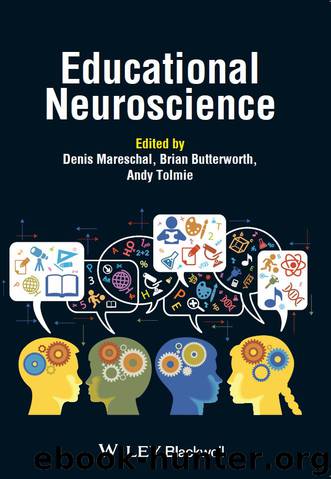Educational Neuroscience by Mareschal Denis; Butterworth Brian; Tolmie Andy

Author:Mareschal, Denis; Butterworth, Brian; Tolmie, Andy
Language: eng
Format: epub
Publisher: John Wiley & Sons, Incorporated
Published: 2013-10-11T04:00:00+00:00
What is the difference in brain activation between dyslexic readers and skilled readers?
So far we have seen that, in the adult brain, the process of normal reading is mediated by a left-lateralized frontoparietal network, including regions such as the IFG, the angular and supramarginal gyri, and a region of the inferotemporal cortex, commonly referred to as the visual word form area. What about abnormal reading? Until the early 2000s only studies of adults existed. Some examined cases of acquired dyslexia following brain injury (as described earlier), while others studied young adults with developmental dyslexia. Among the latter (reviewed by Price & McCrory, 2005), some contradictory findings have emerged due to differences in methodology and sampling. From these early studies, the consensus that emerged was that differences in patterns of activation exist between dyslexic participants and controls within the reading network. Specifically, reduced activation was observed in the left inferior frontal cortex including Broca’s area, implicated in output phonology and articulation processes; supramarginal gyrus, implicated in phonological processing; angular gyrus, implicated in the conversion of visual information to phonological information; and inferior temporal cortex, or visual word form area, implicated in encoding of the abstract identity of visual letter strings and rapid recognition of familiar words, which develops with reading experience (see, e.g., Brunswick, McCrory, Price, Frith, & Frith, 1999; Paulesu et al., 2001). These findings have given rise to the notion that the dysfunction of frontoparietal regions required for phonological processing may lead to the poor development of occipitotemporal regions required for fast recognition of words, and thereby impede accurate and fluent reading. In essence, the suggestion has been that the core deficit in dyslexia is phonological in nature (cf. Snowling, 2000).
A more recent line of research has also implicated visual attention span as contributing to poor reading outcome in dyslexia, independently of a phonological deficit (Bosse et al., 2007; Dubois et al., 2010; Valdois et al., 2003). These studies suggest that dysfunction of left-lateralized superior parietal regions, implicated in visual attention, may be an underlying cause of reading difficulty. For example, Peyrin, Lallier, and Valdois (2008) compared the activation patterns of a group of skilled readers with those of a group of dyslexic participants showing visual attention span disorder. The behavioral reading measure in the study was a global report task. This consists of the brief display of sequences of five consonants (e.g., RSHDM). Individuals with a normal visual attention span are able to perceive all five consonants in one visual fixation, whereas those with a reduced span may only perceive two or three consonants (Valdois et al., 2003). In control participants selective activation during performance of the task was observed in the left angular middle occipital gyrus and left superior parietal lobule, whereas in dyslexic participants with a visual attention span deficit no activation was detected within these regions. Subsequent studies by this group (Peyrin et al., 2012; Valdois, Peyrin, & Baciu, 2009) have used more stringent visual attention span tasks, requiring participants to judge whether two visually
Download
This site does not store any files on its server. We only index and link to content provided by other sites. Please contact the content providers to delete copyright contents if any and email us, we'll remove relevant links or contents immediately.
| Administration & Medicine Economics | Allied Health Professions |
| Basic Sciences | Dentistry |
| History | Medical Informatics |
| Medicine | Nursing |
| Pharmacology | Psychology |
| Research | Veterinary Medicine |
The Art of Thinking Clearly by Rolf Dobelli(9846)
The 5 Love Languages: The Secret to Love That Lasts by Gary Chapman(9217)
Mindhunter: Inside the FBI's Elite Serial Crime Unit by John E. Douglas & Mark Olshaker(8667)
Becoming Supernatural by Dr. Joe Dispenza(7809)
The Road Less Traveled by M. Scott Peck(7255)
Nudge - Improving Decisions about Health, Wealth, and Happiness by Thaler Sunstein(7215)
Mastermind: How to Think Like Sherlock Holmes by Maria Konnikova(6910)
Enlightenment Now: The Case for Reason, Science, Humanism, and Progress by Steven Pinker(6854)
Win Bigly by Scott Adams(6801)
The Way of Zen by Alan W. Watts(6266)
Factfulness: Ten Reasons We're Wrong About the World – and Why Things Are Better Than You Think by Hans Rosling(4474)
The State of Affairs by Esther Perel(4460)
Gerald's Game by Stephen King(4355)
Man's Search for Meaning by Viktor Frankl(4231)
The Confidence Code by Katty Kay(4010)
Thinking in Bets by Annie Duke(3982)
The Worm at the Core by Sheldon Solomon(3307)
Hidden Persuasion: 33 psychological influence techniques in advertising by Marc Andrews & Matthijs van Leeuwen & Rick van Baaren(3280)
Enlightenment Now by Steven Pinker(3263)
